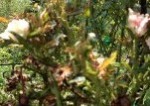 Roses have a reputation of being prone to problems causes by diseases and pests. Unfortunately, there is some truth to this belief but rose’s vary enormously in their susceptibility. Some roses like “American Beauty” are very prone to blackspot while others such as ‘Schneeflocke’ (White Flower Carpet) are resistant. The severity of the problem also varies with climate so that some diseases are only a problem in warm humid climates while being little trouble in dry ones.
Roses have a reputation of being prone to problems causes by diseases and pests. Unfortunately, there is some truth to this belief but rose’s vary enormously in their susceptibility. Some roses like “American Beauty” are very prone to blackspot while others such as ‘Schneeflocke’ (White Flower Carpet) are resistant. The severity of the problem also varies with climate so that some diseases are only a problem in warm humid climates while being little trouble in dry ones.
There are many diseases that can cause trouble for roses but these are the most common ones.
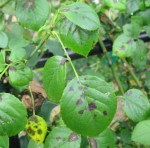
 Blackspot
Blackspot
In a warm humid climate with lots of rain, blackspot is a common problem. It is caused by the fungus Diplocarpon rosae and can be identified by the black spots that occur on leaves, which then turn yellow and drop off the bush. The infection can become so severe that the plant becomes leafless. The spores of the fungus are carried by the wind and overwinter on the stems. The most effect way to control blackspot is to remove all dead plant material underneath the bush and spray with a dormant spray that includes lime sulfur. Watering in the morning or using drip irrigation will help reduce infection by keeping the foliage drier. Systemic fungicides helps prevent infection, contact fungicides helps once the infection is established.
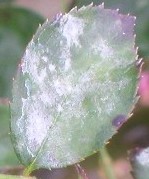
 Mildew
Mildew
There are two kinds of mildew, downy mildew and powdery mildew. Powdery mildew is caused by Sphaeotheca pannosa var. rosa and is identified by a white fuzzy-looking growth on leaves. It infects buds and new growth while older leaves are usually resistant. The spores are wind borne and are especially troublesome when the weather is cool and wet. Plants with dry roots are especially vulnerable.
Downy mildew is a serious fungal disease caused by Peronospora sparsa but is much less common than powdery mildew. It is identified by purple blotches with yellow edges on the tops of the leaves and around the leaf veins and may be mistaken for blackspot. It is most common in cool wet weather. Prevention is very important in controlling both mildews but be forewarned, the systemic fungicides that are normally used against blackspot and powdery mildew do not work against downy mildew.
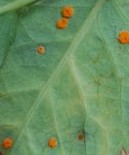
 Rust
Rust
As its name implies this fungus (Phragmidium sp.) looks like rust forming small orange pustules on the leaves that spread and can eventually kill the whole plant. It thrives in cool damp conditions and spreads by wind borne spores. It over winters on the fallen infected rose leaves so prevention includes the removal of debris from underneath the rosebushes. Prompt removal of infected leaves and systemic sprays aid in preventing the disease.
 Rose Balling
Rose Balling
If the buds develop and then fail to open look for the fungus Botrytis cinerea, it is probably to blame. It thrives in cool damp conditions and is especially harmful to roses with many thin petals. Usually only the outer petals are infected and sometimes you can free them from the filamentous web that is enclosing the bud. Spraying with systemic fungicides may prevent an infection but there is no cure.
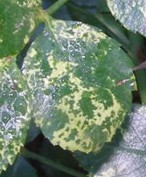
 Rose Mosaic Virus
Rose Mosaic Virus
Mosiac virus can be identified by the yellow streaking or mottling on the leaves and deformed growth. It is spread by grafting and will not spread from one plant to another in your garden. Infected plants often continue to grow and bloom in the garden but you can’t cure it and have to live with it or destroy the plant.
 Rosette
Rosette
This is possibly the worst disease to hit the rose community. It is caused by a virus-like organism that is carried by an invisible air borne mite. Commonly used miticides don’t kill the victor and there is no known cure for the disease. Plants that are infected develop a witches’ broom kind of growth on individual stems that resembles the effect of 2-4 D. 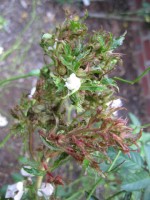
The best way to control disease in roses is by preventing it. This is best accomplished by choosing resistant roses and then giving them excellent growing conditions including good soil, adequate watering, and needed nutrients. Proper pruning and spacing of the bushes at planting time increases air circulation that aids in disease control. In some climates many roses will benefit from spraying a systemic fungicide every week to ten days as a preventative measure. Once disease or pests infect the bushes there may be no stopping it.
